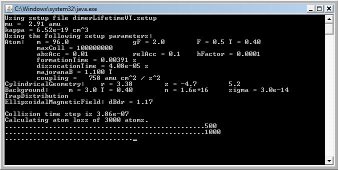Difference between revisions of "Monte Carlo code"
(→Downloading) |
|||
| Line 1: | Line 1: | ||
| − | The buffer gas Monte Carlo code is used for calculating the dynamics of magnetic dipoles evolving in the presence of buffer gas and/or magnetic fields. The version here was written by Nathan Brahms based on the method given in Bob Michniak's thesis. | + | [[Image:MC3runB.jpg|right]]The buffer gas Monte Carlo code is used for calculating the dynamics of magnetic dipoles evolving in the presence of buffer gas and/or magnetic fields. The version here was written by Nathan Brahms based on the method given in Bob Michniak's thesis. |
== Downloading == | == Downloading == | ||
Revision as of 21:25, 17 June 2009
The buffer gas Monte Carlo code is used for calculating the dynamics of magnetic dipoles evolving in the presence of buffer gas and/or magnetic fields. The version here was written by Nathan Brahms based on the method given in Bob Michniak's thesis.Downloading
Version 3 of the Monte Carlo code can be downloaded here.
Just unzip the archive into a new folder and follow the instructions in README.html.
Description
Some of the things this code can be do are:
- Calculate the free evolution of a magnetic atom in a magnetic field.
- Calculate a Monte-Carlo trajectory of a magnetic atom in a cell with a magnetic field present, subject to collisions from a background gas. The user can also perform the same calculation without a magnetic field.
- Make a histogram of the number of Monte-Carlo atoms having left a cell volume vs. time, for magnetic atoms in a cell, starting from a given distribution.
- Calculate a Monte-Carlo distribution of atoms after a specified number of collisions or after an amount of time, starting from a given distribution.
The calculations are performed by first generating a spatial and velocity distribution of dipoles. Each dipole then evolves by classical kinematics. The dipole evolves under the influence of a local magnetic field. After a time, randomly chosen from an exponential distribution, the dipole collides with a random buffer gas atom, with velocity randomly chosen from a Boltzmann distribution. The dipole then evolves under the magnetic field until its next collision. The evolution continues until either a fixed number of collisions has been reached, a set amount of time has passed, or the dipole leaves the geometry of interest.
Help
For help with the code, please first see the code README.html file. If that fails, questions may be direction to Nathan Brahms.
